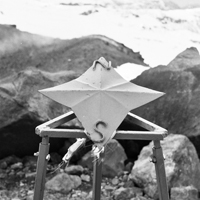
Lights-out at Shibuya Crossing. Photo by CScout.
In the weeks following the devastating March 11 earthquake and tsunami in Sendai, Japan, and the ongoing dilemma that’s happening with the Fukushima Dai-ichi nuclear power plants, we wanted to take a look at what this means to youth culture, not only in Japan, but the United States.
The heartbreaking reality of the situation will take years to sort out, but it’s also reshaping how people are doing business because they have to. It’s also changing perceptions among youth culture that have always looked up to Japan as leaders in two main industries including streetwear and fashion and technology.
As Japanese technology forecasting company in new media, CScout puts it, dramatic change forced upon a nation mean brands need to figure out new ways to reconnect with the public. How can brands adapt and innovate and what’s resulting? They are actually doing an overall study to see what changes are taking place.

Fresh trends from Fashion in Japan from the Spring forecasts.
In several of our studies and reports, one question often asked is “Which country do you think is producing the most fashion-forward styles today?” In our North American Youth Culture Studies, Japan always ranks in the top 3 countries (the USA always being #1), and in one year, Japan actually ranked highest among females overall.
However, as Fashion in Japan has reported in their May reports, many fashion industry experts have canceled their trips to Japan to check-in on latest movements in summer and upcoming Fall fashions from Tokyo because of the difficult circumstances going on in the country. The premium denim industry, which is already taking a toll due to the global recession and high costs of cotton, is particularly troubled by what’s going on in Japan as many top premium denim lines come from this country. (Stay tuned for more on this topic.)
Japanese consumers, who were already less likely to spend on apparel and accessories than they were just 3 years ago as reported in our Japan Youth Culture Study, are feeling the effects of a new buying ethos: One that actually matches what’s been taking place among youth culture in the United States where spending depends on different types of factors including a combination of trendy, inexpensive fast-fashion pieces mixed with heritage, and long-lasting iconic pieces that cost more.
But obviously, there’s much more beyond fashion (yet all are interrelated). As many news reports have noted, we live in such an interconnected world, that the effects are still being uncovered globally, from lack of technical parts needed for mobile phones, to the disruption of car manufacturing. As the 3rd largest economy in the world, Japan is affecting the global marketplace on a scale never before scene.
Internally, as a country that is greatly dependent on nuclear energy to power the nation, it’s dealing as best it can, and affecting how other nations look at nuclear power for their energy needs, instigating another drive for natural and renewable energy sources such as wind, solar, and natural gas. This sort of situation really hits home when you see the lights of Shibuya Crossing, an area known for incredible billboards and advertisements, go dark based on rolling black-outs, indicating that of course Tokyo is greatly affected as well. In a country where trains run like clock-work but are now delayed, where new technology especially with mobile phones is expected among youth culture, but not being produced, and packaged goods at convenience stores and vending machines are in shorter supply, all of this is effecting change and creating a new type of DIY generation.
In our VALs psychodemographic studies several years ago, when comparing the U.S. youth market with Japanese youth markets, when it came to behavioral traits, it was interesting to note that the Japanese youth market was motivated by Achievement -more so than the U.S. youth market, which ranked higher as Idealistic. Notable traits among Japanese youth culture were the high rankings for achieving their goals, brand consciousness, acceptability among friends and family, and less of a desire to lead others rather than be a leader as group of friends instead of completely solo.
In comparison, the U.S. youth behavioral traits were also notably Seekers and driven by a primary motivation for self-expression (which is also important among young Japanese but in certain contexts and as a group). Spontaneity was much higher among youth in the U.S. However, we’re already seeing how this is changing, as reported by our Japanese youth culture managers, many of whom say youth demographics have been forced outside of their comfort bubble and are figuring out new ways to create self-expression within their altered lifestyles.
In some ways, like youth markets in parts of the Middle East, China, and India, Japanese youth culture is using their social media skills to demonstrate their frustration with the reaction of their government to deal with the Fukushima nuclear power plant situation, not to mention the devastation from the Tsunami and earthquake in Sendai. This is presenting an opportunity that’s reshaping youth interaction with the political system, which is also affecting traditional forms of hierarchy within businesses as well.

Socks and clogs in the streets of Tokyo among notable street fashion styles this Spring.
The ripple effects are noted here in the United States, especially as Japanese streetwear trends are an ongoing source of inspiration. While North America, Europe, and Japan all have their versions of streetwear and upper urbanwear trends, including their own designers and collaborations, the fastest growing market pushing the evolution are individuals themselves, and this has often taken place in Japan -those who simply make their own streetwear fashion out of a variety of sources, including a range of high-end pieces mixed with inexpensive but personally chic strategies. These people, the unknown style-sensitives of street couture often have no aspirations to become the next Watanabe or Takahashi, but simply gain inspiration from their surroundings and enjoy their own sense of individuality and expression through fashion. It is the expression that is changing now. A news sense of Japanese hope and rebuilding, which is seeping over into their lifestyles including fashion. These people are the real crop of new leaders pushing trends in the quiet underground. It’s through their personal sense of style that gets the rest of us to take notice, and quite honestly, follow.
On the flip side, Americana, military, and heritage remain strong trends among young males in Japan, while classic clogs, boots, denim shorts, and 70’s flowing skirts and dresses, are among the top trends among young females.
Both genders still take inspiration from the United States, but will youth culture in the U.S. rank Japanese fashion as high as it once did as leaders in style? We’re figuring that out now with a new set of research.

Hatsune Miku–to debut in a virtual holographic concert at Anime Expo in July in Los Angeles.
In terms of animation, manga, J-Pop, and J-Rock, youth in the U.S. are still as enamored as ever. Anime Expo announced today, May 17, that Hatsune Miku, a Japanese virtual pop idol whose computer-generated singing and holographic performances which have sparked a new form of musical entertainment, will debut in “concert” at Anime Expo in Los Angeles from July 1 – 4, 2011. Fans are already furiously blogging about this.
What’s also notable is how youth culture in United States has rallied together by creating a variety of fundraising events for Japan, and across many industries from music, sports, fashion, manga, and video gaming. It’s brought humanitarian attention to the country and support that may also reshape how we once thought about this country: Perhaps as producers of a new way of doing business, creating strategies that are once again leading-edge, but not from industrialization and modernization, but from a different source of creativity, from necessity, which has always been the mother of invention.


